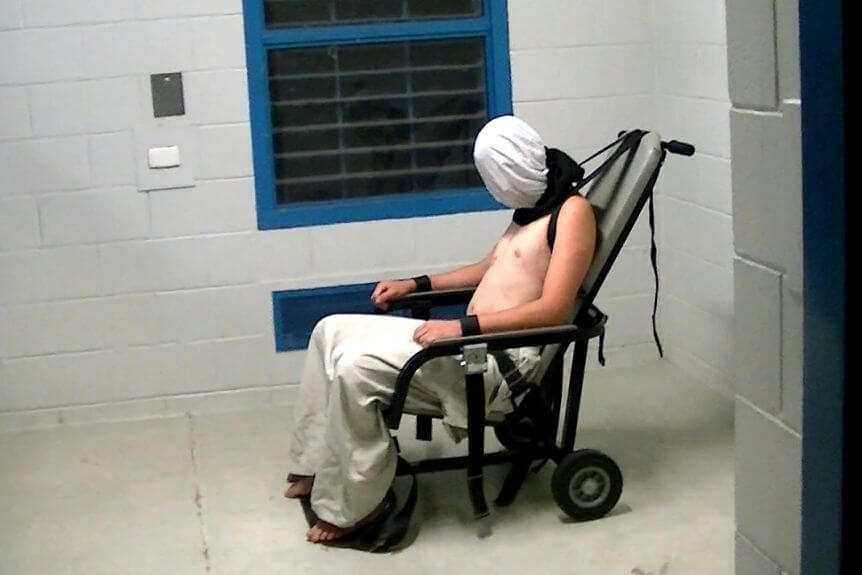The call to ban spit hoods in Australian prisons has renewed following the campaign from the family of an Indigenous man who died in custody.
Wiradjuri, Kokatha and Wirangu man Wayne Fella Morrison was 29 years old when he died in Yatala Labour Prison in September 2016.
Morrison was involved in an altercation when prison guards restrained him. They placed him in a spit hood and then placed him face-down in the back of a prison transport van.
When they pulled him from the van, he was unconscious. He died at Royal Adelaide hospital two days later when his family had to turn off his life support.
Justice for Wayne Fella Morrison
Since his death, Morrison’s family has been calling for a state and federal ban on spit hoods in prisons and police stations.
The inquest into the death of Wayne Fella Morrison will sit again in an hour — where the Chief Executive of SA’s Department of Correctional Services will continue his evidence. An explainer of his evidence out this evening with @IndigenousXLtd.#JusticeForFella pic.twitter.com/cvN9lr22Ed
— alison whittaker (@AJ_Whittaker) May 31, 2021
A coronial inquest into Morrison’s death heard that there was more than a two-minute delay before any guard attempted to resuscitate Mr Morrison. The inquest also heard that less than half the corrections officers present had up-to-date first aid certificates.
Mr Morrison’s family’s lawyer told the coronial inquest that after Mr Morrison was taken to the Royal Adelaide Hospital, his mother and sister had to wait hours in the hospital car park before they were allowed to visit their dying son.
Spit Hoods in Australian Prisons

Spit hoods are a mesh fabric hood which is meant to conceal the face and restrain the person. Most often there fixed at the base with a band around the neck.
The hoods are meant to protect corrections workers from spitting or biting. However, there have been many instances of asphyxiation from the hoods.
Damning footage of Dylan Voller strapped to a chair and wearing a spit hood for almost two hours is embedded in the consciousness of many Australians.
The Four Corners episode which sparked the Royal Commission into the Protection and Detention of Children in the Northern Territory revealed Australia’s dirty secret of excessive force in prisons.
South Australian Ombudsman Wayne Lines in 2019 recommended the phasing out of the use of hoods within a year after a report highlighted horrific stories of spit hoods in youth detention. Stories include that of a 13-year-old girl who five correctional officers pinned down, her face pushed into the cement in a prone position.
Lines said the hoods were also in breach of international rules around the treatment of prisoners. He also said that they increased the risk of potentially fatal asphyxiation. This is because children were often pinned in a prone position by several adults to get the hood on their head. The use of spit hoods has been linked to deaths in custody in the UK and United States.
Renewed use in the COVID era
The debate as to the effectiveness of spit hoods ebbed during the COVID pandemic. They appeared as a way to protect police officers and correctional guards from potentially contracting the virus.
In March of last year, Irish police ordered 16,000 more spit hoods as COVID-19 descended on the world.
In April of last year, a representative of the Police Federation in the UK told the Home Affairs Select Committee that spit hoods should be “in the pocket of every single police officer” to protect from the “appalling weaponisation of COVID-19 by some individuals”. This was a recommendation which the committee subsequently endorsed.
However in June, the Police Service of Northern Ireland revealed to Amnesty that the manufacturers explicitly declare that spit hoods provide no protection against COVID-19 spread, stating: “The product will not prevent aerosols from coughing or sneezing and is therefore not an effective means to prevent Covid-19.”
Ban spit hoods in Australian Prisons
Spit hoods are excessive, brutal and unnecessary. O’Brien Criminal & Civil Solicitors believes that the use of spit hoods in Australian prisons only serves as an increased risk of deaths in custody and their use should immediately cease. Spit hoods do not prevent transmission of COVID-19. The risks of placing a spit hood on someone deeply outweigh the benefit of the prevention of spitting and biting. Spit hoods are rarely used in isolation of any other restraints. They are usually used in conjunction with mechanical restraints including handcuffs, ankle ties and the like and as such there are other methods to prevent the biting of an inmate.
Join us in signing the petition through the link on this post – SIGN THE PETITION





